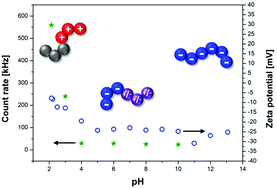Amphiphilic and double hydrophilic block copolymers containing a polydehydroalanine block†
Abstract
We present the synthesis and characterization of amphiphilic and double hydrophilic block copolymers containing a polydehydroalanine (PDha) block. First, polystyrene-block-poly(tert-butoxycarbonylaminomethyl acrylate) (PS-b-PtBAMA) and poly(n-butylacrylate)-block-poly(tert-butoxycarbonylaminomethyl acrylate) (PnBA-b-PtBAMA) were prepared by atom transfer radical polymerization (ATRP). Subsequent deprotection led to the corresponding PS-b-PDha and PnBA-b-PDha block copolymers. All intermediate stages were characterized by 1H-, 13C- or solid state MAS 13C-NMR. Afterwards, the solution behavior of PAA-b-PDha was investigated by a combination of dynamic light scattering, zeta potential measurements, and potentiometric titration – revealing that aggregation occurs upon reaching pH values of 3 or lower. In case of PS-b-PDha, core-corona micelles are formed in aqueous solution, as revealed by a combination of DLS and cryogenic transmission electron microscopy.



 Please wait while we load your content...
Please wait while we load your content...